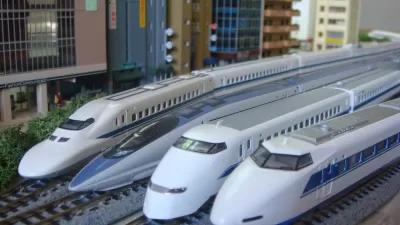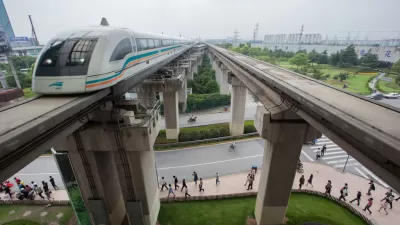The line may only be 12 miles, but the train speeds at 312 mph. The Secretary of Transportation was in Japan as part of the effort to bring high speed rail to the U.S. though it's not clear whether he is in fact considering the maglev technology.
Japan is anxious to find customers for its fast trains, particular maglev, the fastest type of train. The world's first high speed rail is The Shinkansen that opened in 1964, also in Japan - but some in the U.S. feel that the latest technology should be considered for U.S. HSR corridors.
"Very fast," Mr. LaHood said after stepping off the maglev at a track nestled here in mountains west of Tokyo. "We're right at the start of an opportunity for America to be connected with high-speed, intercity rail," he said.
"Maglev, short for "magnetic levitation," uses powerful magnets that allow the train to float just above the track, reducing friction. The train starts off on wheels, then gravitates upward after reaching high speeds
Japan has also been goaded into a new export boldness by the rise of China, a rival whose surge in construction of high-speed rail networks could give Beijing an economies-of-scale edge in the global railway market.
Central Japan Railway, which is based in Nagoya and is more commonly known as JR Central, is promoting its N700-I trains, which are in use in Japan and can run at a top speed of about 330 kilometers (205 miles) an hour. If Japan does not start selling maglev trains overseas, it risks losing its technological edge, Hitoshi Ieda, a professor in civil engineering at the University of Tokyo, warned. Unless JR Central can win a contract, the maglev, for now, could stay nothing more than a novelty."
Thanks to Mark Boshnack
FULL STORY: Japan Starts to Shop Its Bullet Train Technology

Maui's Vacation Rental Debate Turns Ugly
Verbal attacks, misinformation campaigns and fistfights plague a high-stakes debate to convert thousands of vacation rentals into long-term housing.

Planetizen Federal Action Tracker
A weekly monitor of how Trump’s orders and actions are impacting planners and planning in America.

In Urban Planning, AI Prompting Could be the New Design Thinking
Creativity has long been key to great urban design. What if we see AI as our new creative partner?

Cal Fire Chatbot Fails to Answer Basic Questions
An AI chatbot designed to provide information about wildfires can’t answer questions about evacuation orders, among other problems.

What Happens if Trump Kills Section 8?
The Trump admin aims to slash federal rental aid by nearly half and shift distribution to states. Experts warn this could spike homelessness and destabilize communities nationwide.

Sean Duffy Targets Rainbow Crosswalks in Road Safety Efforts
Despite evidence that colorful crosswalks actually improve intersection safety — and the lack of almost any crosswalks at all on the nation’s most dangerous arterial roads — U.S. Transportation Secretary Duffy is calling on states to remove them.
Urban Design for Planners 1: Software Tools
This six-course series explores essential urban design concepts using open source software and equips planners with the tools they need to participate fully in the urban design process.
Planning for Universal Design
Learn the tools for implementing Universal Design in planning regulations.
Appalachian Highlands Housing Partners
Gallatin County Department of Planning & Community Development
Heyer Gruel & Associates PA
Mpact (founded as Rail~Volution)
City of Camden Redevelopment Agency
City of Astoria
City of Portland
City of Laramie




























